I Hate Icloud How Do I Gain Control of My Storage Again
Nosotros remember of "the cloud" equally an amorphous space without limits. That may be true in the amass, merely each of our personal cloud storage accounts has limits, and in comparison to the terabyte-sized drives in our Macs, our deject accounts are frequently quite modest. Nevertheless, you tin can usually get for years without bumping into their limits. I certainly did.
But when you practise run out of space, it can be a major problem, since files may stop syncing, electronic mail could get rejected, and all sorts of other havoc could ensue. I recently hit this problem with iCloud, Dropbox, and Google.
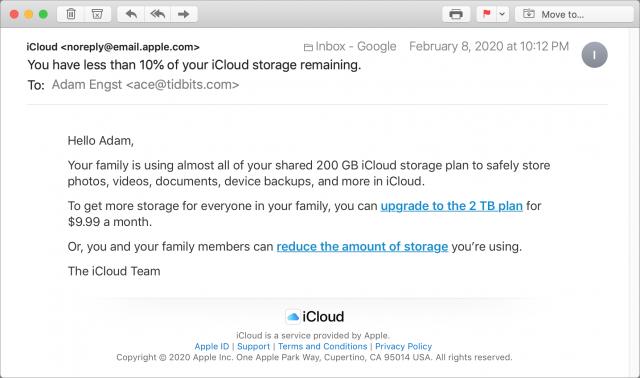
Here's how to deal with such a situation.
Notice Out How Much You're Using
First off, how much cloud storage space do you have, and how much are you using? These numbers aren't hard to determine, and here's where to look.
Apple
Yous can make up one's mind your iCloud limit and usage on either a Mac or an iOS device. In macOS ten.14 Mojave, look at the graph at the bottom of Organization Preferences > iCloud. In x.fifteen Catalina, the graph is in Organization Preferences > Apple ID > iCloud. In iOS, yous'll find a like graph at Settings > Your Proper name > iCloud.
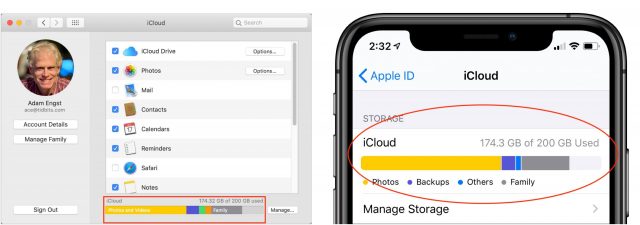
Dropbox
For Dropbox, you could look on the service'due south Web site, just it's easiest to click the Dropbox icon in your card bar and so click your avatar in the upper-right corner. You lot can encounter that I solved my Dropbox problem a few months back.
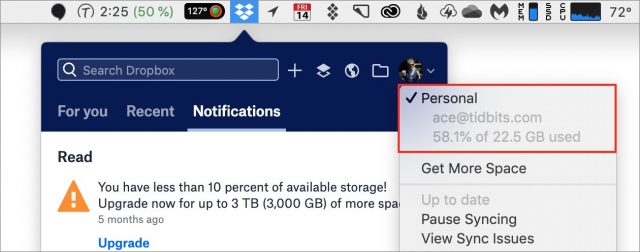
In Google Bulldoze, wait at the bottom of the left-hand sidebar. You can also find that number at the bottom-left corner of the Gmail Spider web interface. I was at 35.95 GB of 36 GB before I did some cleaning, and I tin clear more than infinite quickly if necessary.
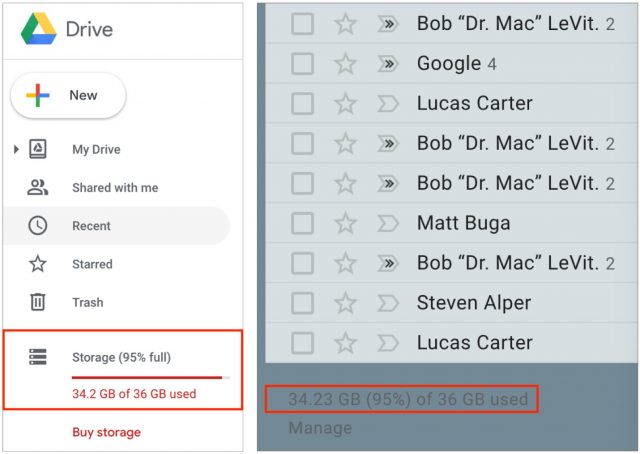
Purchase More than Space
In that location is an easy solution to running out of space, of course, which is to buy more than storage. Apple, Dropbox, and Google all charge $9.99 per month for 2 TB of space. Apple and Google are considerate plenty to provide less expensive plans as well. You can buy 50 GB of iCloud storage for $0.99 per month, or 200 GB for $two.99 per month. If you lot demand more than space from Google, it will accuse you $1.99 per calendar month for 100 GB or $two.99 per calendar month for 200 GB.
Unsurprisingly, given that it doesn't have other lines of business, Dropbox is the pushiest about encouraging you lot to upgrade. It provides merely ii GB for free, although many people have more than from recommending the service to friends in the past. Apple is the next stingiest, with just v GB of costless iCloud storage, after which you'll need to purchase more than. Google offers 15 GB for free, but that nevertheless may non concluding long, betwixt Gmail, Google Bulldoze, Google Photos, and more than.
(I've never seriously used Microsoft OneDrive, and so I tin't comment on how well it compares to the others functionally. It provides either v GB for gratis for anyone or 1 TB per user for free with an Office 365 subscription. You lot can expand that in 200 GB chunks for $2 per 200 GB, upwardly to 2 TB total.)
Ownership more than infinite is unsatisfying, however, particularly if you're on the edge of your free allocation and don't desire to deal with another monthly bill. Dropbox is annoying in a slightly dissimilar mode—you might be offended at having to pay for two TB when you'll never apply more than 20 GB.
Happily, if yous're anything similar me, there are a number of ways you can reduce the corporeality of storage that y'all're using, and thus either delay or eliminate the demand to ante up for more than space. They vary a bit by service, so allow'due south touch on each in plow.
Remove Unnecessary iCloud Device Backups
With iCloud, there's often an easy fashion yous tin can recover multiple gigabytes of storage quickly. If you back up your iPhone and iPad to iCloud, those backups count against your overall storage space. And count they do—the backup of my iPhone xi Pro consumes 10.1 GB.
It's likely, all the same, that you're storing backups for older devices unnecessarily. Navigate to Settings > Your Name > iCloud > Manage Storage > Backups to see what you lot have. When Tonya and I did that, we discovered that we both had backups for our previous iPhones still in iCloud. At over 5 GB each, deleting those (tap i and so tap Delete Backup) cleared a bunch of space quickly.
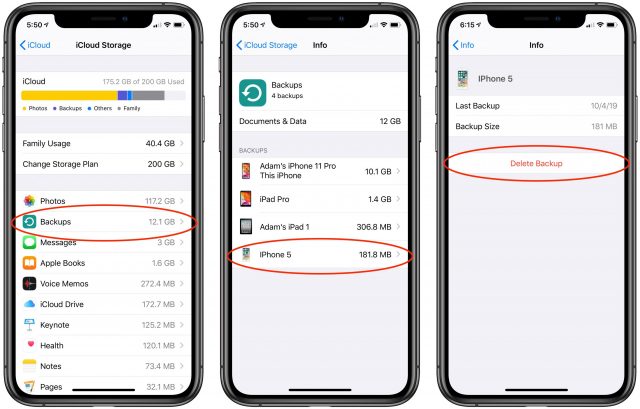
(The fact that we're sharing 200 GB for our family account meant both that Tristan and nosotros would all accept been impacted if nosotros'd run out of space, and that all of us could help by clearing useless backups.)
Scan for and Clear Out Bloated iOS Apps
While you lot're in the iCloud Storage screen (the leftmost screenshot above), look at the other apps at the top of the list. If you employ iCloud Photos, the Photos app volition probable exist using far and above the most storage, just there isn't much yous can practise virtually that, apart from deleting unnecessary screenshots, duplicate photos, and adventitious videos of your feet in Photos. Yous may be able to automate some of that work, just there will likely be plenty of manual try as well.
However, another apps may exist using space unnecessarily. When I got Apple's alarm and checked the iCloud Storage screen, the Photographic camera+ 2 app was one of the tiptop offenders. That's because I used it to take nearly 2000 outburst photos of cross land races. I had gone through each burst, picked the best shot, and saved it to Photos for editing and sharing. Merely I hadn't deleted all the bottom images, and they were consuming over eleven GB of iCloud infinite: v.69 GB in iCloud itself and some other 5.69 GB in my iCloud backup. Oops.
Similarly, Apple Books was eating 1.6 GB of space, but when I went to see what was actually in in that location, I realized I had 40 or 50 old Have Control books notwithstanding stored. I take all those elsewhere, then deleting them cleared another 600 MB of space.
Finally, pay attention to Messages. If you regularly trade photos and videos in conversation conversations, it could exist some other place you tin salve significant space. In the iCloud Storage screen, tap Messages > Elevation Conversations to run across which of your conversations are the largest. Tap ane to switch to Letters, tap the person'south avatar at the superlative of the chat, tap the Info push button, scroll down to come across the photos, and tap Evidence All Photos. Tap Select, tap photos you lot have no desire to proceed, and and then tap Delete at the bottom-right of the screen.
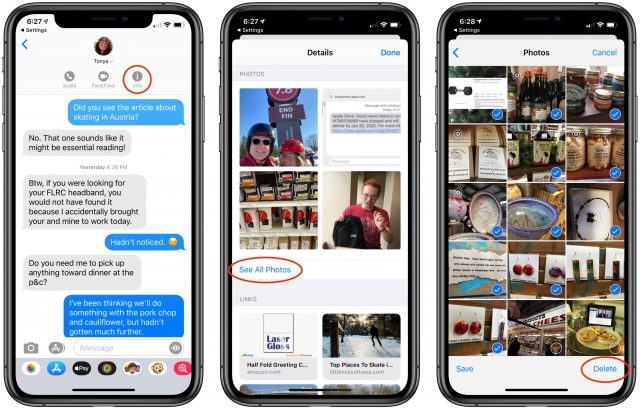
Likewise, enabling Messages in iCloud can salve a little space because iCloud has to shop just one copy of each message, rather than a copy for each device you dorsum upwardly. Plow information technology on by enabling the Messages switch in Settings > Your Name > iCloud.
Stop Backing Up Bloated iOS Apps
There is 1 other fashion y'all tin salvage infinite in your iCloud backups—avoid backing up apps that comprise large quantities of unnecessary data. In my case, Camera+ ii is likely to have a lot of data in it regularly, so it might make sense to exclude it from my iCloud backups, especially since I ordinarily process my photos quickly after a race, so they would exist vulnerable to being lost for only a day or 2.
To see if you have any apps that are consuming a lot of space in your backups, navigate back to Settings > Your Name > iCloud > Manage Storage > Backups, and tap the proper name of the device you're on. Along with telling y'all when your last backup was, how large information technology was, and how large the next one volition be, that screen (eventually; it's not quick) tells you which apps are consuming the most space in your backup. Tap the toggle switch next to an app to stop backing it upwardly and delete its data from your fill-in.
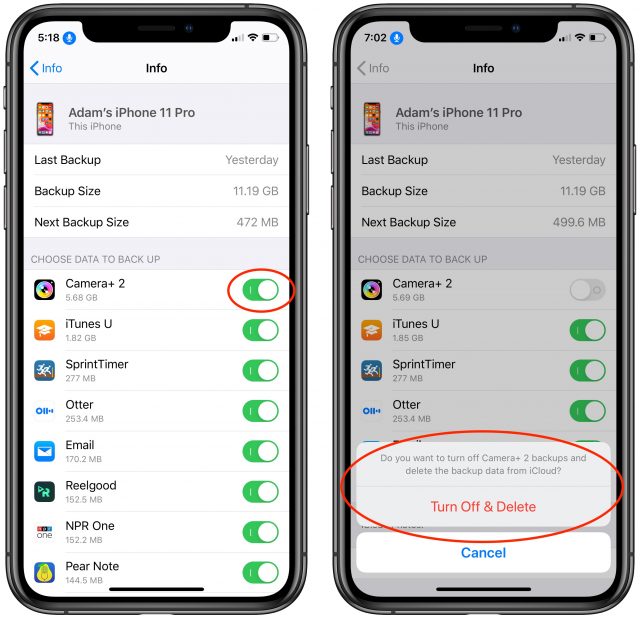
Delete Quondam Email
Both iCloud and Gmail count your email against your storage space, which means that if you lot run out of infinite, they'll reject incoming messages. That would be bad, and then yous don't want to get to that indicate.
For near people, e-mail probably isn't as significant a consumer of storage space every bit files, but if yous're an email packrat similar me, you lot could exist wasting gigabytes of space on unnecessary letters. How yous deal with these varies by service.
iCloud
When it comes to clearing email, iCloud is no different from any other IMAP-based email provider. I'll presume y'all're using Apple'south Mail; the general principles, if non the specific steps, may work for other electronic mail clients.
If you lot want to archive messages locally before deleting them from iCloud, you can do that in one of two means.
- Choose Mailbox > New Mailbox, choose On My Mac from the Location pop-upwardly menu, and proper noun your mailbox. And so select the letters you want to save and cull your newly created mailbox from the Move To push button's carte du jour in Mail'southward toolbar.

- If you want to archive an unabridged mailbox, kickoff elevate information technology from the iCloud account section of the sidebar in Post to the On My Mac section to copy information technology there. It may take a while to copy.
To delete individual letters, you lot can just select them and delete them however y'all commonly do that (I press the Delete cardinal). However, if you're looking for the most bang for your bump, cull View > Sort by > Size get-go to put the largest letters at the meridian so you lot can delete those starting time.
Of grade, deleting messages normally just moves them to the Trash mailbox; to reclaim the space they occupy on iCloud, choose Mailbox > Erase Deleted Items > AccountName. In one case yous do that, the messages are gone for good.
If you want to remove an entire mailbox and its contents, select information technology in the sidebar and choose Mailbox > Delete Mailbox. That deletes all of its letters immediately and can't exist undone.
One note: Mail service has a Message > Remove Attachments command that, equally you'd look, removes attachments from selected messages. Since attachments are frequently the signal of the messages I receive, that command makes me uncomfortable, only if you don't value attachments much, or just desire to remove some egregiously large attachments from certain messages, it could assistance you salve space apace. I recommend using it later on sorting past size and filtering past letters with attachments, equally you can see in the screenshot above.
Gmail
Considering Gmail's IMAP support was tacked on to give users the pick of using email clients like Apple'south Mail, information technology's best to work in Gmail's native Web interface when clearing infinite. But first, what if you want a local archive of a collection of messages earlier you delete them?
I had some Gmail labels (which Mail maps to mailboxes) that I no longer needed, but that I was didn't desire to delete permanently. I never know when I might want something buried in the archeological depths of my email, so I made local copies of those messages before removing them. I tried several techniques before deciding that the most straightforward arroyo was too the best.
Showtime, since I don't actually use Mail much, I had to enable the On My Mac section of the Mail sidebar by choosing Mailbox > New Mailbox, choosing On My Mac from the Location popular-up menu, and then naming the mailbox (which I wasn't planning to apply; I deleted information technology later).
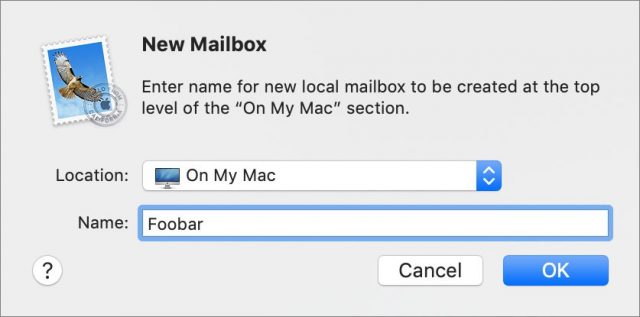
And then I dragged the mailbox I wanted to download locally from its position in the Gmail mailbox hierarchy to the On My Mac section. That copies the entire mailbox locally—it doesn't change the Gmail version at all. Depending on the size of the mailbox (most of my mailboxes had every bit many as xxx,000 messages, and my largest one contained virtually 325,000 messages), it could take many minutes or fifty-fifty hours. And think, a watched copy never completes—let information technology run while you practise other things or fifty-fifty overnight.
Once you're sure that the entire mailbox has copied locally—I recommend spot-checking messages from the height, middle, and lesser of the mailbox—it'southward time to delete the messages within Gmail. Every bit I noted, do this in Gmail's Web interface; anything else is decumbent to confusion and error. Follow these steps:
- Either click a label or perform a search to select the messages you want to delete. If you're searching, be very, very careful that you're non accidentally finding skilful letters too. Remember that you can add together
-searchtermto a search to exclude messages that comprise "searchterm" every bit well. - Click the checkbox at the summit of the checkbox column. That selects all the messages showing on that screen. In most cases, there will be many more screens; Gmail tin can only display 100 messages per screen.
- In the banner at the top, click "Select all X conversations in 'LabelName.'" Gmail changes the banner to signal that all the conversations are selected.

- Click Delete in the toolbar to move all those letters to Trash (or, in Gmail terms, to apply the Trash characterization to those letters). If you're working with tens of thousands of messages, this may have several minutes. And if, like me, you take hundreds of thousands of messages to trash, Gmail may be able to work with only 5,000 or x,000 or then at a time, requiring you to repeat the option and trashing process many times.
- Click Trash in the label list sidebar. You may need to click More at the bottom of the sidebar to see it.
- The banner at the top tells you that letters in Trash for more than thirty days will exist deleted automatically. If you aren't hurting for space immediately, you could allow the automatic inaugural delete these messages for adept. If you need the space back right abroad, click Empty Trash Now.

- A dialog appears, telling you how many messages will exist deleted. In my experience, Gmail often fails to delete all of them at once, so if the dialog disappears and messages remain in Trash, merely click Empty Trash At present every bit many times every bit is necessary to clear everything.
A search that you might find useful in Step 1 is has:attachment larger:10m. As you might look, it finds messages with attachments that are larger than x MB. Y'all tin can change that number to any other size you desire.
Recollect that y'all can open up multiple browser windows for Gmail, which makes it easy to exercise the slow-move delete/trash trip the light fantastic toe repetitively throughout the solar day while yet being able to read and reply to new messages.
Information technology can take some time—perhaps even a 24-hour interval or two—for Gmail's space measurements at the bottom of the screen to update. I take to presume that Gmail is an insanely circuitous arrangement behind the scenes, with information potentially distributed betwixt data centers and backed up in diverse ways, then it doesn't surprise me that there isn't a tight connection between your deportment and the space measurements. Avoid running completely out of infinite if you possibly tin can!
Remove Yourself from Shared Dropbox Folders
Folders that are shared with you by other people count against your Dropbox storage limits. That may not seem fair, but proceed it in heed, since you may be able to recover significant amounts of storage past removing yourself from large shared folders.
To do that, look for folders in your Dropbox binder that have 3 little people on their icons. That indicates the folder is shared, although information technology doesn't tell you lot whether or non you're the owner.
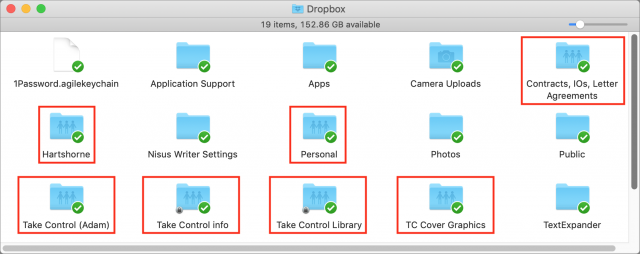
To decide who the owner is, Control-click a shared Dropbox folder and choose Share from the contextual card. And so, in the window that appears, await at the right side. If you lot're not the owner, click the pop-upward card to the correct of your name and click Remove My Access.
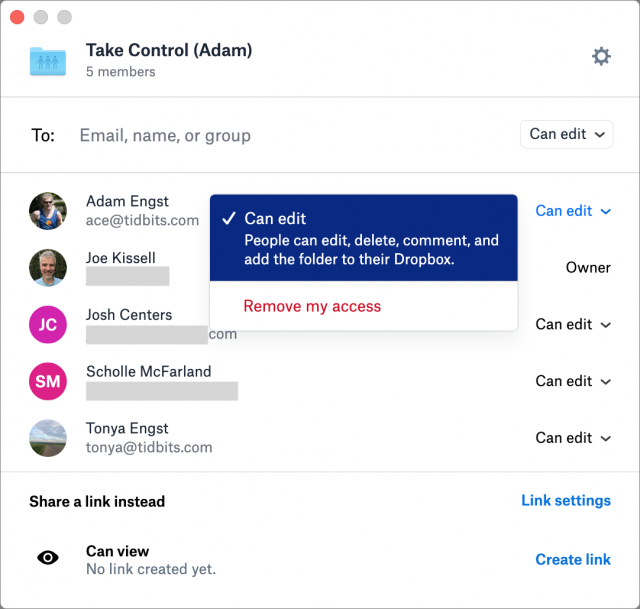
You will, of form, lose access to that shared folder immediately, and you can't become it back without asking the owner to share with you again, and so make sure you've made a local copy of any necessary data beforehand.
Google is much friendlier in this situation—anything in the Shared With Me category in the Google Bulldoze sidebar does not count against your storage limit.
Scan for Large Files
Since Dropbox, Google Drive, and iCloud Drive all shop standard files, ane useful way to articulate space is to evaluate their contents with a utility that reveals particularly big files and folders. Numerous apps can do this for any drive or binder, including the gratis GrandPerspective and OmniDiskSweeper. I'm partial to GrandPerspective'due south graphical view, but OmniDiskSweeper's textual approach is equally constructive. If neither of them floats your gunkhole, Josh Centers says he's a big fan of the $9.99 DaisyDisk.
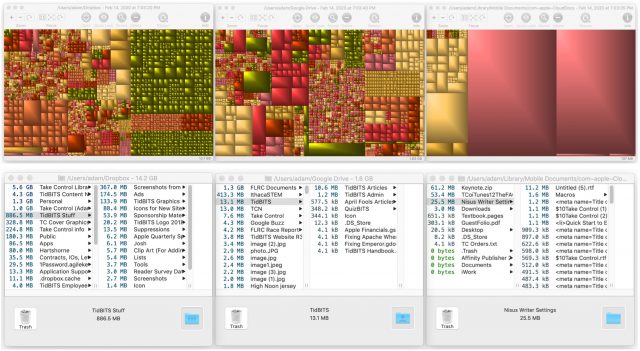
In either case, you'd want to scan the folders that stand for to your Dropbox folder, the Google Bulldoze folder (assuming you're using Google's Fill-in and Sync app), and iCloud Drive. Then look for files that are especially big and either delete them outright or just motion them to another binder on your Mac.
In that location'southward no magic here, and you should be careful when really deleting files, only it'southward mutual to discover that yous're wasting a pregnant amount of space on files that don't affair.
streetmanglanking.blogspot.com
Source: https://tidbits.com/2020/02/17/how-to-deal-with-running-out-of-icloud-google-and-dropbox-space/
0 Response to "I Hate Icloud How Do I Gain Control of My Storage Again"
Post a Comment